#1870s britain
Explore tagged Tumblr posts
Text
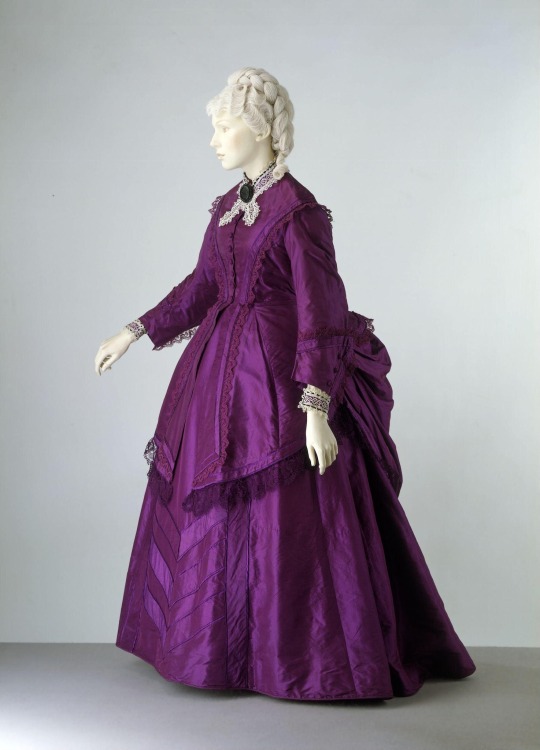
Purple silk day dress, 1870-1873, British.
Victoria and Albert Museum.
#aniline dye#womenswear#extant garments#dress#silk#19th century#V&A#purple#1870#1870s#wedding#1870s wedding#1870s britain#Britain#wedding dress
272 notes
·
View notes
Text

Clovelly, England 1870s
#clovelly#england#1870s#europe#history#vintage#photography#architecture#people#street life#19th century#places#uk#britain#stairs
99 notes
·
View notes
Text

Walter Crane (British, c.1845-1848) Europe, Asia, Africa, detail, c.1870
#Walter Crane#British art#british#great britain#britian#orientalism#oriental#art#fine art#european art#classical art#europe#european#fine arts#oil painting#europa#europe asia africa#1870#1800s
56 notes
·
View notes
Text
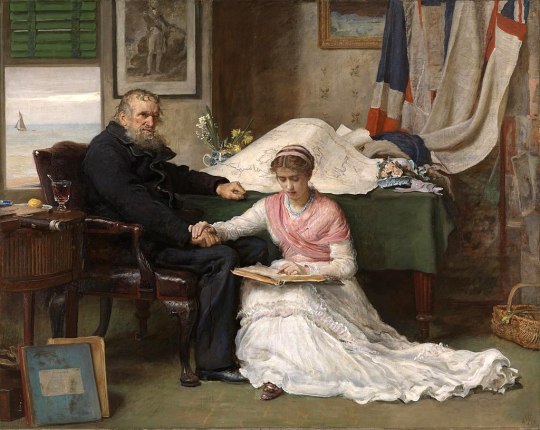
John Everett Millais (1829-1896) "The North-West Passage" (1874) Oil on canvas Pre-Raphaelite Located in the Tate Britain, London, England The painting depicts an elderly sailor sitting at a desk, with his daughter seated in a stool beside him. He stares out at the viewer, while she reads from a log-book. On the desk is a large chart depicting complex passageways between incompletely charted islands.
Millais exhibited the painting with the subtitle "It might be done and England should do it", a line imagined to be spoken by the aged sailor. The title and subtitle refer to the repeated failure of British expeditions to find the Northwest Passage, a navigable passageway around the north of the American continent. These expeditions "became synonymous with failure, adversity and death, with men and ships battling against hopeless odds in a frozen wilderness." The search for the northwest passage had been undertaken repeatedly since the voyages of Henry Hudson in the early 17th century. The most significant attempt was the 1845 expedition led by John Franklin, which had disappeared, apparently without trace. Subsequent expeditions had found evidence that Franklin's two ships had become stuck in ice, and that the crews had died over a number of years from various causes, some having made unsuccessful attempts to escape across the ice. These later expeditions were also unable to navigate a route between Canada and the Arctic. Millais had the idea for the painting when a new expedition to explore the passage, the British Arctic Expedition led by George Nares, was being prepared.
#paintings#art#artwork#genre painting#genre scene#john everett millais#oil on canvas#fine art#pre raphaelite#pre raphaelism#tate britain#museum#art gallery#history#art analysis#northwest passage#exploration#1870s#late 1800s#late 19th century#interior#clothing#clothes#male portrait#portrait of a man#female portrait#portrait of a woman#father and daughter
238 notes
·
View notes
Photo





Wardrobe designed by Christopher Dresser, c. 1876
#furniture#wood#gold#woodwork#frogs#amphibians#animals#Britain#Christopher Dresser#this is so cool#fav#victorian#19th century#1870s
345 notes
·
View notes
Photo
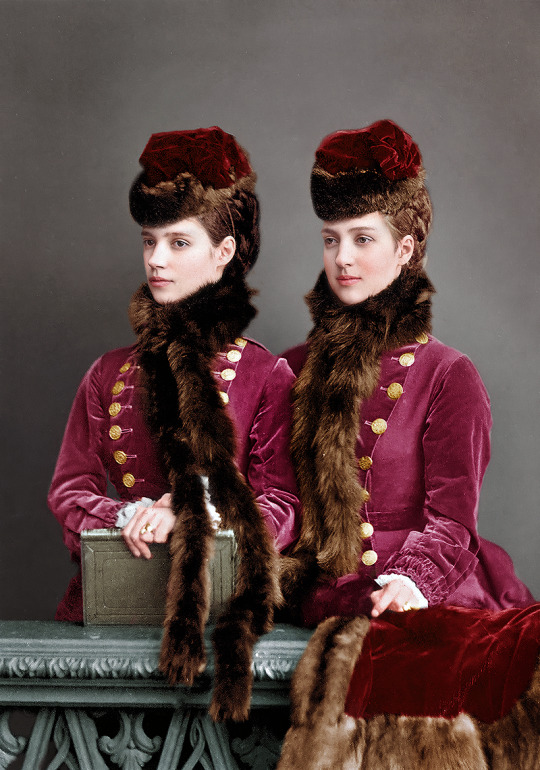
Empress Maria Feodorovna of Russia with her sister Queen Alexandra of the United Kingdom, during Russian state visit in 1873.
#Empress Maria Feodorovna of Russia#Empress Maria of Russia#Empress Maria Feodorovna#Empress Maria#princess dagmar of denmark#Queen Alexandra of Great Britain#Queen Alexandra of United Kingdom#Queen Alexandra#princess alexandra of denmark#Princess Alexandra of Wales#Tsarevna Maria#Princess of Wales#1870s#1873#1870s fashion#victorian#romanovs#imperial russia#Imperial Family#british royal family#british royals#British Royalty#denmark royalty#denmark royals#Dagmar of Denmark#alexandra of denmark#history colored#digital coloring#colored photography#b&w picture coloring
255 notes
·
View notes
Text

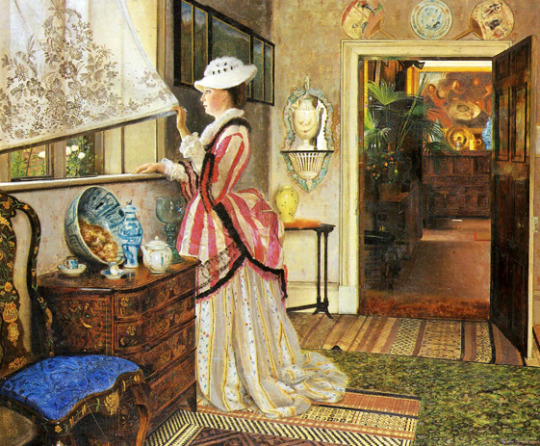

Summer by John Atkinson Grimshaw, 1875
54 notes
·
View notes
Text

2 notes
·
View notes
Text
was thinking about this

To be in "public", you must be a consumer or a laborer.
About control of peoples' movement in space/place. Since the beginning.
"Vagrancy" of 1830s-onward Britain, people criminalized for being outside without being a laborer.
Breaking laws resulted in being sentenced to coerced debtor/convict labor. Coinciding with the 1830-ish climax of the Industrial Revolution and the land enclosure acts (factory labor, poverty, etc., increase), the Metropolitan Police Act of 1829 establishes full-time police institution(s) in London. The "Workhouse Act" aka "Poor Law Amendment Act of 1834" forced poor people to work for a minimum number of hours every day. The Irish Constabulary of 1837 sets up a national policing force and the County Police Act of 1839 allows justices of the peace across England to establish policing institutions in their counties (New York City gets a police department in 1844). The major expansion of the "Vagrancy Act" of 1838 made "joblessness" a crime and enhanced its punishment. (Coincidentally, the law's date of royal assent was 27 July 1838, just 5 days before the British government was scheduled to allow fuller emancipation of its technical legal abolition of slavery in the British Caribbean on 1 August 1838.)
---
"Vagrancy" of 1860s-onward United States, people criminalized for being outside while Black.
Widespread emancipation after slavery abolition in 1865 rapidly followed by the outlawing of loitering which de facto outlawed existing as Black in public. Inability to afford fines results in being sentenced to forced labor by working on chain gangs or prisons farms, some built atop plantations.
---
"Vagrancy" of 1870s-onward across empires, people criminalized for being outside while being "foreign" and also being poor generally.
Especially from 1880-ish to 1918-ish, this was an age of widespread mass movement of peoples due to the land dispossession, poverty, and famine induced by global colonial extraction and "market expansion" (Scramble for Africa, US "American West", nation-building, conquering "frontiers"), as agricultural "revolutions" of imperial monoculture cash crop extraction resulted in ecological degradation, and as major imperial infrastructure building projects required a lot of vulnerable "mobile" labor. This coincides with and is facilitated by new railroad networks and telegraphs, leading to imperial implementation or expansion of identity documents, strict work contracts, passports, immigration surveillance, and border checkpoints.
All of this in just a few short years: In 1877, British administrators in India develop what would become the Henry Classification System of taking and keeping fingerprints for use in binding colonial Indians to legal contracts. That same year during the 1877 Great Railroad Strike, and in response to white anxiety about Black residents coming to the city during Great Migration, Chicago's policing institutions exponentially expand surveillance and pioneer "intelligence card" registers for tracking labor union organizing and Black movement, as Chicago's experiments become adopted by US military and expanded nationwide, later used by US forces monitoring dissent in colonial Philippines and Cuba. Japan based its 1880 Penal Code anti-vagrancy statutes on French models, and introduced "koseki" register to track poor/vagrant domestic citizens as Tokyo's Governor Matsuda segregates classes, and the nation introduces "modern police forces". In 1882, the United States passes the Chinese Exclusion Act. In 1884, the Ottoman government enacts major "Passport Nizamnamesi" legislation requiring passports. In 1885, the racist expulsion of the "Tacoma riot".
Punished for being Algerian in France. Punished for being Chinese in San Francisco. Punished for being Korean in Japan. Punished for crossing Ottoman borders without correct paperwork. Arrested for whatever, then sent to do convict labor. A poor person in the Punjab, starving during a catastrophic famine, might be coerced into a work contract by British authorities. They will have to travel, shipped off to build a railroad. But now they have to work. Now they are bound. They will be punished for being Punjabi and trying to walk away from Britain's tea plantations in Assam or Britain's rubber plantations in Malaya.
Mobility and confinement, the empire manipulates each.
---
"Vagrancy" amidst all of this, people also criminalized for being outside while "unsightly" and merely even superficially appearing to be poor. San Francisco introduced the notorious "ugly law" in 1867, making it illegal for "any person, who is diseased, maimed, mutilated or deformed in any way, so as to be an unsightly or disgusting object, to expose himself or herself to public view". Today, if you walk into a building looking a little "weird" (poor, Black, ill, disabled, etc.), you are given seething spiteful glares and asked to leave. De facto criminalized for simply going for a stroll without downloading the coffee shop's exclusive menu app.
Too ill, too poor, too exhausted, too indebted to move, you are trapped. Physical barriers (borders), legal barriers (identity documents), financial barriers (debt). "Vagrancy" everywhere in the United States, a combination of all of the above. "Vagrancy" since at least early nineteenth century Europe. About the control of movement through and access to space/place. Concretizing and weaponizing caste, corralling people, anchoring them in place, extracting their wealth and labor.
You are permitted to exist only as a paying customer or an employee.
#get to work or else you will be put to work#sorry#intimacies of four continents#tidalectics#abolition
3K notes
·
View notes
Text
From Glens Falls to Chester: The Mills family in the Adirondacks
This was originally the second chapter in my family history on the Mills family, but has been adapted and changed for this blog. All the sources are noted in a bibliographic essay at the end of this post, with maps and other photos throughout. Enjoy! This was originally posted on the WordPress version of this post. It has been split in a few posts so it is more readable on here.
By 1860, the Mills family was still in Bolton. John Mills was said to be 54 years old, still a miller, and his wife Margaret, age 36, was listed as a housekeeper. There were nine children in the household. Two of them, Joseph B., age 18, and Thomas, age 14, were farm laborers, presupposing that the Mills family owned a farm in Bolton. While Hetabella, age 18, did housework, the other children seemed to be too young to be listed with occupations. They included Edward (age 12), Dory A (age 10), Mary J (age 6), John C (age 4), Margaret E (age 3) and Benjamin W. (age 3/12). Bolton was similar to what it was in 1855, still undoubtedly having an agricultural and working-class character.
Four years later, in 1864, a woman named Margaret E. Mills declared loyalty to US, withdrawing loyalty to Great Britain and Ireland. This woman is likely Margaret Bibby. Unfortunately she did not state her age or place of birth.
The following year, 1865, the Mills family had moved back to Chester. John Mills was a 60-year-old farmer with his wife Margaret, 40 years old. This is the first census which states the number of John and Margaret’s children, which numbers 12! Within the household in the frame house, were 10 children, meaning that two of her children were not in the household. The names of those two children are not currently known. This census was the first to name Robert B. Mills, a person who was 2 ½ years old. Others in the household included Hattie B. Mills (age 21), Joseph B Mills (age 20), Thomas Mills (age 18), Edward Mills (age 18), Dora A. Mills (age 14), Mary J. Mills (age 9), John C. Mills (age 7), Margaret E Mills (age 5), and William Mills (age 4). With such a big family, it is likely that Hattie (same as Hetabella) took care of the family, especially Dora, Mary, John C., Margaret E., and William, who were younger than her. Joseph B. and Thomas likely worked on the farm with their father. This can only be inferred as the census does not state this directly.
Chester seemed to the same in some respects as it was when the Mills family lived there in the late 1830s and early 1840s. Nearby to the Mills family was the family of George Bibby. He was a 46-year-old farmer born in Ireland, with a family of six: his wife Ann born in the county, age 30, has five children, now married; Helen, age 9, Katherine, age 7, Samuel, age 6, William, age 4, and George, age 1 and 8/12. Also living in the household is his father, Samuel Bibby, age 67, born in Ireland, a laborer.
Another family nearby was Thomas Bibby’s family, living in the household of the Wallaces. Hewas age 28, born in Ireland, a farmer and married to someone named Mary A. Bibby (age 25, born in Warren). There is also a family of Thomas Mills (age 59, born in Ireland, farmer) nearby who has a wife named Margaret (age 53, born in Ireland, has 12 children), John (age 23), Edward L (age 21), Margaret (age 19), Phebe (age 15), Thomas J (age 11), and Ellen Gray (sister, age 60, born in Ireland). It is not known if any of the Mills children were living with these individuals at the time, but is likely that they were living somewhere in Chester.
By 1870, the Mills family was still living in Chester. John Mills was a 66-year-old farmer married to Margaret, age 48. In the household was their 23-year-old son, Joseph B., a carpenter, their 21-year-old son, Edward E, a farm laborer, and their 19-year-old daughter, Dora A, a teacher. At home were the rest of the children, Mary J (age 17), John C (age 14), Maggie (age 11), Willie or William (age 7), and Robert or RBM II (age 5). Both John and Margaret noted that they had parents of foreign birth. Also on the same page was Samuel Bibby (age 73 born in Ireland), Thomas Mills (age 64, farmer, born in Ireland), his wife Margaret (age 57, born in Ireland), Thomas Bibby (age 34, born in Ireland).
As the years passed by, John and Margaret were getting older. As her Find A Grave entry reports, since she has no visible gravestone photo, she died in 1874 in Minerva, Essex County, New York. This cannot be disproved or proven by any records on the subject.
The 1875 census shows a 70-year-old John Mills still living in Chester, as a farmer, with seven children in the household. These included his son Joseph B, a 29-year-old millwright, his daughter Dora, 24-years-old, his daughter Mary, 21-years-old, his son John C, 18-years-old, his daughter Maggy, 16-years-old, his son William, 14-year-old, and his daughter Hattie, 31-years-old. The latter was married to a 37-year-old carpenter named Hannibal Hammond and had a 12-year-old child named Ellen. It is important to note that Margaret is not in the household, so from this record, her death date can be ante 1875, or more accurately sometime between 1870 and 1875. While the census takers could have missed her, considering she was in every since census since 1850 seems to indicate that she was not alive.
The families of Isaac Mills and George Bibby were also living in the area. Isaac Mills’s family consists of: Isaac (born in Ireland, age 62, farmer), Ann (wife, age 46, born in Ireland), Joseph W (age 26, born in Warren, farmer?), Edward B? (farmer? Age 24, born in Warren), Mary (age 21, born in Warren), James O (age 20, born in Warren). George Bibby’s family consists of: George (age 53, farmer, born in Ireland), Ann (wife, age 40, born in Warren), Ellen (age 20, born in Warren), Caty (age 20, born in Warren), Samuel (age 16, born in Warren), William B (age 18, born in Warren), Albert (age 8, born in Warren), Humbert, (8 11/12 months, born in Warren), and Samuel (father, age 78, born in Ireland, likely a farmer of some type). These two families may have been connected together by marriage or even Isaac could have been John Mills’s brother. Sadly, those specifics are not completely known.
In 1876, John Mills died in Minerva, Essex County, New York, apparently while he continued his job as a miller. I have contacted appropriate historical societies in hopes of gathering more information. It is possible that Mills family members were living in that area of New York, or even Bibby family members since his wife Margaret was buried there. Perhaps she was going on a trip to bisit her cousins or even her parents. We don’t know exactly but can only make historical suppositions.
To this day, the Warren County Historian’s Office has family files on the Mills and Bibby families. 17 individuals with the Mills surname living in Ireland (mainly in Cork) and two with the Bibby surname were living near or around Kilkenny at the time (1876).
By 1876, with the death of John Mills, the twelve children he fathered with his wife Margaret, were on their own. Each of them would chart their own, independent path. As Charles Frederic Goss wrote many years later, RBM I, was only 10 (or 12) when his father died. This likely had a strong psychological effect on him, as it would on anyone, especially one who is that young. It meant that those such as RBM I, his brother William, and other younger siblings had to make their own way.
By 1876, Dora was only 25-years-old, if we use the age in the 1875 census. She likely did not even know of the Packard family in Massachusetts or of a man named Cyrus Winfield Packard, who was only 24 at the time, and would later be her husband. She had not, like Cyrus, run away from home at a young age. This is not because she worked more than Cyrus, who came from a family of hard-working farmers who had roots dating back to Samuel Packard, an immigrant from England in 1638, and had moved from eastern Massachusetts, mainly in Bridgewater, to Western Massachusetts, specifically in Cummington and Plainfield. Instead, she possibly found at least some value in her life as a teacher and likely helping around the home (and probably the farm). This would serve her well in years to come.
© 2018-2023 Burkely Hermann. All rights reserved.
#mills family#packard family#mills#packard#genealogy#family history#1870s#1638#immigration#settler colonialism#early settler#settler violence#1830s#1840s#1860s#19th century#massachusetts#ireland#britain#marriage#family#households
0 notes
Text
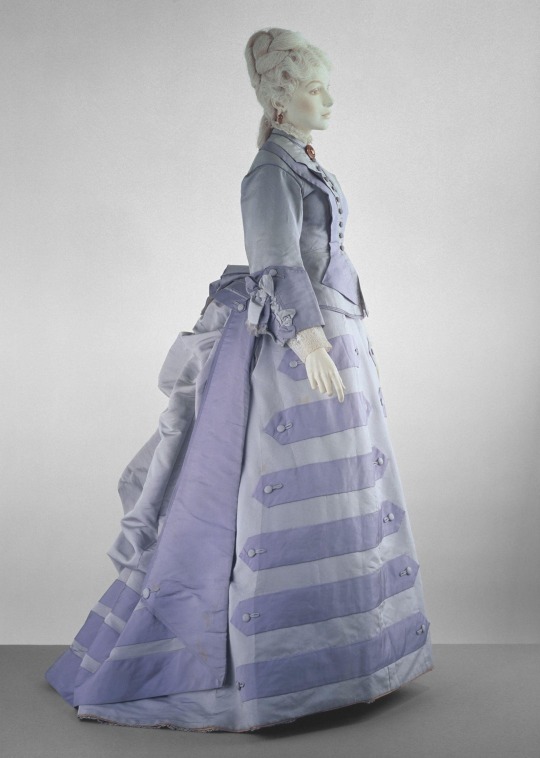
Lilac silk afternoon dress, 1872-1875, British.
Victoria and Albert Museum.
#lilac#purple#womenswear#extant garments#dress#silk#19th century#Britain#1872#V&A#1870s#1870s dress#1870s extant garment#1870s britain#afternoon dress
336 notes
·
View notes
Text
An elderly Welsh woman stands outside her small house, 'Tŷ unnos', in rural Wales, United Kingdom of Great Britain and Ireland, c. 1880.

Una anciana galesa parada afuera de su pequeña casa, 'Tŷ unnos', en la zona rural de Gales, Reino Unido de Gran Bretaña e Irlanda, c. 1880.
6 notes
·
View notes
Text



London, England 1870/1910
#london#england#1870s#1910s#uk#britain#europe#history#vintage#1900#photography#bw#pics#architecture#people#street life#19th century#places#traffic#westminister abbey#river thames#night#cityscape#panorama#everyday life#fleet street#big ben
143 notes
·
View notes
Text
newsies fandom I love you dearly, but why do we reference the time period that newsies takes place in as the 'Victorian Era" when we have another term that quite literally describes the period of history and the place that newsies is set in?
If you didn't know, the Victorian Era is tied directly to the history of Great Britain and coincides with Queen Victoria's reign from 1837 to 1901. It was a time of social reform and significant advances in science and technology.
In the United States, we have a term that refers to the period after the American Civil War or the 1870s to 1890s. This term is the "Gilded Age". The Gilded Age in US history was so named because it was a time of political corruption and serious social problems (like child labor, poverty, and Jim Crow laws) thinly veiled or "gilded" by a golden mask of economic expansion and industrialization.
The newsboys' strike of 1899 was set against the backdrop of the Gilded Age, not the Victorian Era. It might seem like a small thing to nitpick, and both periods bare resemblance to each other, but I swear it's so important when looking at the history and the context of the time.
87 notes
·
View notes
Text
Below are 10 featured Wikipedia articles. Links and descriptions are below the cut.
*... And Intemperate
The 1966 New York City smog was a major air-pollution episode and environmental disaster, coinciding with that year's Thanksgiving holiday weekend. Smog covered the city and its surrounding area from November 23 to 26, filling the city's air with damaging levels of several toxic pollutants.
Anactoria (or Anaktoria; Ancient Greek: Ἀνακτορία) is a woman mentioned in the work of the ancient Greek poet Sappho. Sappho, who wrote in the late seventh and early sixth centuries BCE, names Anactoria as the object of her desire in a poem numbered as fragment 16. Another of her poems, fragment 31, is traditionally called the "Ode to Anactoria", though no name appears in it.
The Badge Man is a figure that is purportedly present within the Mary Moorman photograph of the assassination of United States president John F. Kennedy in Dealey Plaza on November 22, 1963. Conspiracy theorists have suggested that this figure is a sniper firing a weapon at the president from the grassy knoll.
The Destroying Angel and Daemons of Evil Interrupting the Orgies of the Vicious and Intemperate is an 1832 English oil painting on canvas by English artist William Etty, first exhibited in 1832. Etty had become famous for nude paintings, and acquired a reputation for tastelessness, indecency and a lack of creativity. With The Destroying Angel he hoped to disprove his critics with an openly moral piece.
The 1881 world tour of King Kalākaua of the Hawaiian Kingdom was his attempt to save the Hawaiian culture and population from extinction by importing a labor force from Asia-Pacific nations. Critics in Hawaii believed the labor negotiations were just an excuse to see the world. The 281-day trip gave Kalākaua the distinction of being the first monarch to circumnavigate the globe.
The murder of Sir William de Cantilupe, who was born around 1345, by members of his household, took place in Scotton, Lincolnshire, in March 1375. The chief suspects were two neighbours—a local knight, Ralph Paynel; and the sheriff, Sir Thomas Kydale—as well as de Cantilupe's entire household, particularly his wife Maud, the cook and a squire. The staff were probably paid either to carry out or to cover up the crime, while Paynel had been in dispute with the de Cantilupes for many years; it is possible that Maud was conducting an affair with Kydale.
The nuckelavee is a horse-like demon from Orcadian folklore that combines equine and human elements. British folklorist Katharine Briggs called it "the nastiest" of all the demons of Scotland's Northern Isles. The nuckelavee's breath was thought to wilt crops and sicken livestock, and the creature was held responsible for droughts and epidemics on land despite being predominantly a sea-dweller.
Surtsey is an uninhabited volcanic island located in the Vestmannaeyjar archipelago off the southern coast of Iceland. It was formed in a volcanic eruption which began 130 metres (430 feet) below sea level, and reached the surface on 14 November 1963. It was intensively studied by volcanologists during its eruption, and afterwards by botanists and other biologists as life forms gradually colonised the originally barren island.
The Tichborne case was a legal cause célèbre that fascinated Victorian Britain in the 1860s and 1870s. It concerned the claims by a man sometimes referred to as Thomas Castro or as Arthur Orton, but usually termed "the Claimant", to be the missing heir to the Tichborne baronetcy.
"Well he would, wouldn't he?" is a British political phrase and aphorism that is commonly used as a retort to a self-interested denial. The Welsh model Mandy Rice-Davies used the phrase while giving evidence during the 1963 trial of the English osteopath Stephen Ward. Ward is considered to have been made a scapegoat for the Profumo affair, a scandal involving John Profumo, the Secretary of State for War. During the trial, Ward's lawyer James Burge asked Rice-Davies whether she was aware that Lord Astor—a hereditary peer and Conservative politician—had denied having an affair with her; Rice-Davies replied "Well he would, wouldn't he?"
46 notes
·
View notes
Photo
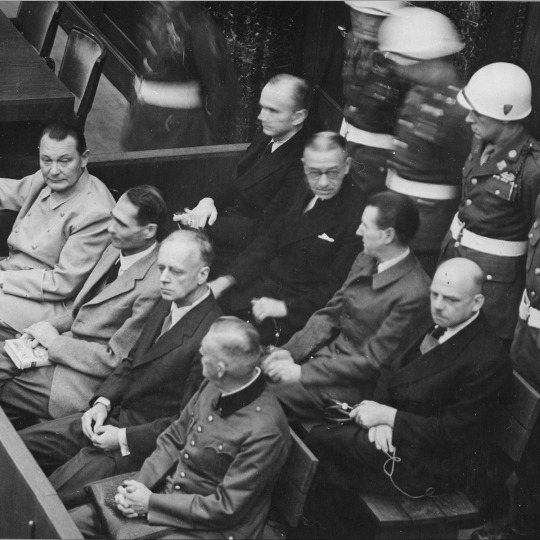
Nuremberg Trials
The Nuremberg trials (1945-6), held in Nürnberg (Nuremberg), Germany, were a series of trials involving the senior surviving Nazis to hold them accountable for waging war and committing war crimes and crimes against humanity during the Second World War (1939-45). 22 Nazis were tried, with 19 found guilty and sentenced to either death by hanging or lengthy prison terms.
The first Nuremberg trials were conducted from November 1945 to October 1946, and then, a second phase, which involved a much larger number of defendants, was conducted from November 1946 to April 1949. The Nuremberg trials were the first in history where the victors in a war sought to make senior figures from the losing side accountable for their actions. The trials were filmed and contributed greatly to our understanding of how WWII was conducted and revealed both the irrefutable evidence for and enormous scale of such atrocities as the Holocaust. The first month of the trials, the initial proceedings only, were hosted in the Supreme Court Building in Berlin, but they moved on 20 November to the Palace of Justice in Nuremberg. The Palace of Justice was selected because it had been the heart of Nazi show trials against enemies of the Third Reich, the city was the home of the Nuremberg Rally, the infamous annual Nazi Party congress, and the complex had the practical advantage of an adjoining prison where the defendants were detained.
The International Military Tribunal
At the close of WWII, the victorious Allies of France, Britain, the United States, and the USSR, as agreed by their respective leaders at a conference in Moscow back in October 1943, jointly formed an International Military Tribunal (IMT) to bring German Nazi war criminals to justice. There were some calls to have judges from neutral nations head the IMT, but the allied leaders were determined to be directly involved in getting their pound of flesh. The idea of the trials was supported by a number of other nations besides the four main powers.
The panel that would decide the fate of the defendants brought before the IMT consisted of one judge and one prosecutor from each of the four nations mentioned above. The judging panel was presided over by the British judge Lord Justice Geoffrey Lawrence, described by one American lawyer as "like God...Hollywood would have cast him" (MacDonald, 23). The chief Soviet judge was I. T. Nikitchenko, the French lead judge was Henri Donnedieu de Vabres, and the US judge was Francis B. Biddle. The legal proceedings followed the common law practice applied in the United States and Britain. Translators worked in the courtroom, and everyone present had access to a set of headphones. There was a large screen to show the court relevant film clips and statistical information. 250 journalists attended the court sessions, and the whole proceedings were filmed and sound recorded.
Nuremberg Trials Judges
U.S. Army (CC BY-NC-SA)
In the closing stages of the war, Adolf Hitler (1889-1945), Joseph Goebbels (1897-1945), and Heinrich Himmler (1900-1945) had all committed suicide, but there remained 24 senior Nazi figures whom the Allies were determined to bring to justice. The group was selected not only for their individual roles but also as representatives of particular Nazi institutions. Before the trials could begin, Robert Ley (1890-1945), head of the German Labour Front, committed suicide, and Gustav Krupp (1870-1950), an industrialist who had used forced labour, was considered too physically frail to stand trial. The 22 remaining defendants faced four charges, as expressed in the Oxford Companion to World War II, they were:
Count 1: Contributing to a common plan or conspiracy to wage war
Count 2: Crimes against peace
Count 3: War crimes (e.g. violations of the Geneva Convention such as the abuse and murder of prisoners of war, use of prisoners for labour, destruction of private property, and devastation of property and places with no military justification)
Count 4: Crimes against humanity (e.g. the murder of civilian populations, use of slave labour, the forced deportation of civilians, and the persecution of specific social, political, religious, and racial groups)
Counts 1 and 2 proved problematic to define, and therefore it was difficult to find the defendants either innocent or guilty of them. This is hardly surprising considering the debate amongst historians ever since as to why and how WWII started and how far one should go back exactly in order to discover the causes of WWII, causes which could be attributed in some cases to both the victors and losers. The court essentially considered counts 1 and 2 as involving actions such as breaking international treaties and invading and occupying free countries. Much easier to establish were cases of counts 3 and 4, although even here there was the added complication that the victors had themselves been guilty of what would today be called war crimes, for example, the Allied bombing of Germany, submarine attacks on unarmed vessels, and the Katyn Forest massacre of Polish prisoners of war by USSR forces. Certain facts were taken as given, such as that Hitler had fully intended to start a world war. In addition, such Nazi organisations as the Gestapo (secret police), the SS (Schutzstaffel), and SA (Sturmabteilung) were condemned as criminal organisations.
Palace of Justice, Nuremberg
US Army (Public Domain)
The judges not only benefitted from the cross-examination of the defendants but also the testimony of around 360 witnesses (including both victims of and members of the Nazi regime) and a huge quantity of incriminating documents, official and otherwise, including indisputable photographs, sound recordings, and films, such as those taken at concentration and death camps. As noted by Dr Robert Kempner, a lawyer who had fled the Nazi regime:
One of the biggest helps to us was the German bureaucratic sense – they kept everything and they even made publications and films and lot of material had been discovered by our Allied search teams. Some of the people like General Governor Frank of Poland was so anxious to show his friend Hitler after the war what he has done that he kept diaries, volumes and volumes and volumes. In fact he had written his own indictment.
(Holmes, 593)
It is important to note, however, that the documentation for Nuremberg was compiled in order to support the legal case that the defendants were guilty of one or more of the four counts (and not to create a comprehensive reconstruction of past events as, say, a historian would do). There was, too, a degree of negotiation between the various national judges regarding particular defendants – the USSR judge, for example, wanted Rudolf Hess hanged while his fellow judges preferred a prison sentence – but there was a conscious effort on all parties to deliberate with as much fairness as possible given the seriousness of the trials and the world's scrutiny of them. To this end, the defendants were collectively represented by a legal counsel, Otto Kranzenbühler, and permitted individual lawyers to present their defence.
Camp Guard Giving Evidence at Nuremberg
Imperial War Museums (CC BY-NC-SA)
Continue reading...
38 notes
·
View notes